A hanging basket is one of the most versatile ways to decorate your home with flowers and decorative plants.
It allows us to utilize the vertical space and also provides us with an opportunity to decorate a space that was not possible otherwise.
One common way to use a hanging basket is by planting some beautiful and vibrant flowers in it. But do all kinds of flowers grow well in a hanging basket?
Definitely not! So, in this article, we shall learn about the 15 best flowers for hanging baskets along with their basic care. Let’s get right into it.
Begonia boliviensis
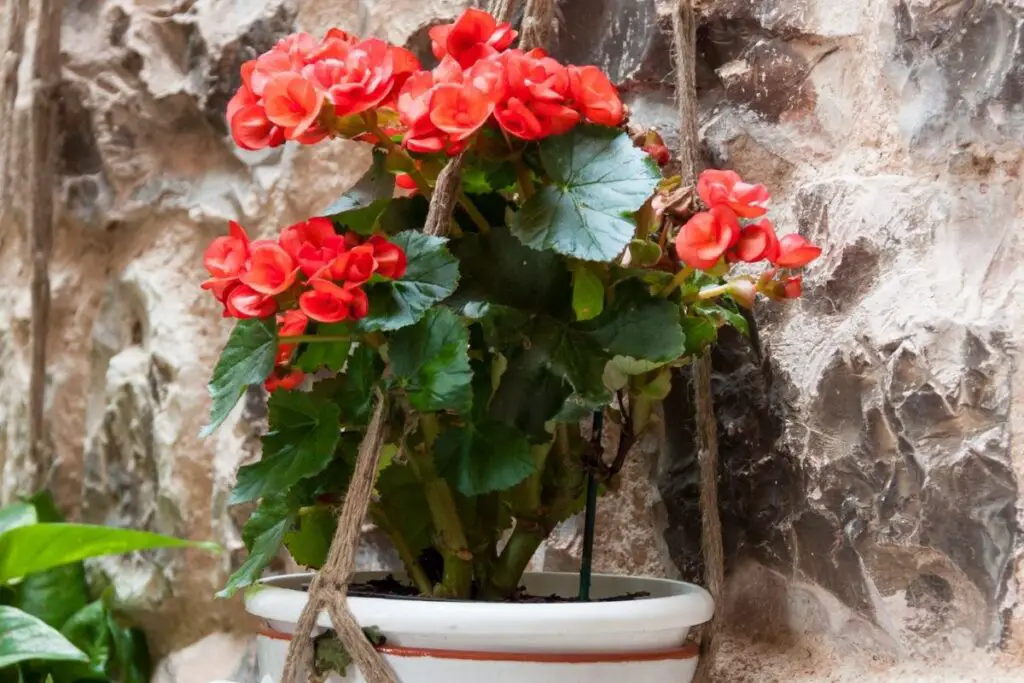
Begonia boliviensis belongs to the begonia family with full, lush blooms, making it perfect for hanging baskets.
Their flowers have clustered waxy petals and wing-shaped leaves. They need a sunny spot to bloom easily throughout their life. They can grow in baskets throughout the year.
Sunlight: Begonia boliviensis likes and needs a lot of light to grow. They can grow in semi-shade and thrive in sunny spots. Keep them in a spot where they can receive ample light; it can be near a window or a balcony.
Watering: Water the soil of begonia boliviensis when the soil is dry. As you keep them in full sun, you have to water them twice a week. Check the soil before watering to make sure the soil is dry.
Fertilizer: Fertilize the plant in summer with mineral fertilizer by diluting the fertilizer. You can feed the plant with compost at the beginning of the spring. Do not fertilize them in the dormant period as it can stress the plant.
General care: Begonia boliviensis are quite resistant to pests and diseases. Prune the falling flowers and check the plant regularly. Repot them when the roots overgrow the pot.
Fuchsia
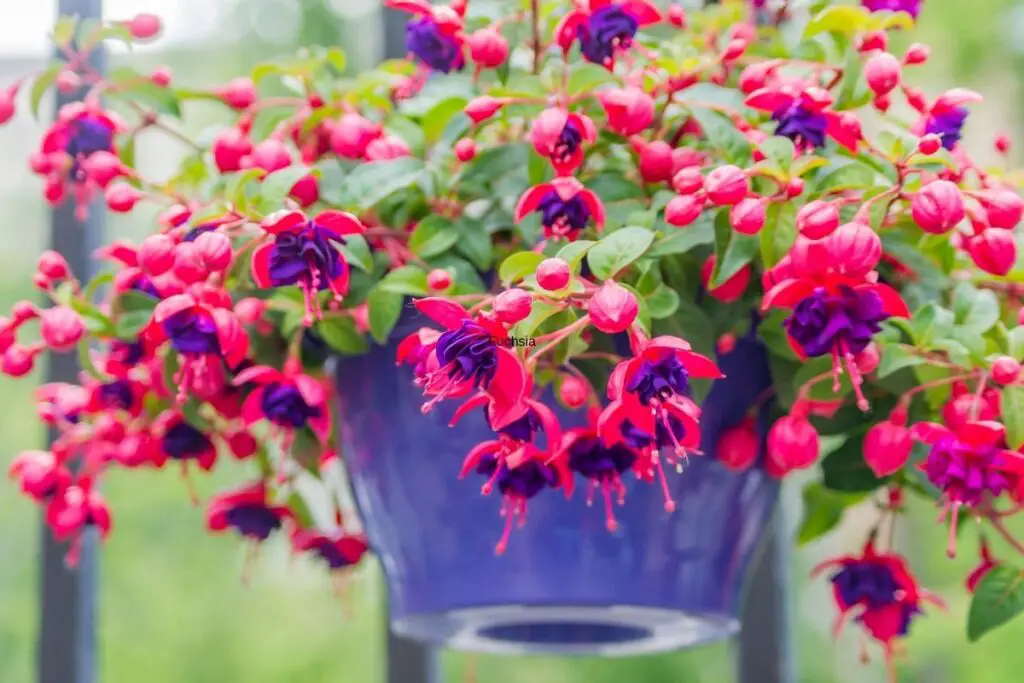
Fuchsia is a beautiful flower that produces flowers in a variety of colors such as pink, purple, white, red, multicolor.
You can grow them in baskets, and they look beautiful as flowers droop from baskets. They are shade-loving tender plants as they appreciate cool areas.
Sunlight: Fuchsia likes cool areas and is not very fond of hot climates. You must keep them in filtered light, dappled light, and not direct light. Keep it in a spot with bright indirect light.
Watering: Water fuchsia when the soil is relatively dry. Do not keep its soil wet and touch the soil before watering to check the soil’s moistness.
Fertilizer: Feed fuchsia with fertilizer during spring and summer. You can use diluted fish emulsion to fulfill their nutrient needs. Stop feeding during the dormant period.
General care: Fuchsia likes humid areas and room temperature; it will encourage plants growth and bloom. During hot weather, it’s better to keep fuchsia in a shaded area to support their blooming. Pinch off the plant after the blooming has finished. Use only clean sterilized scissors.
Impatiens
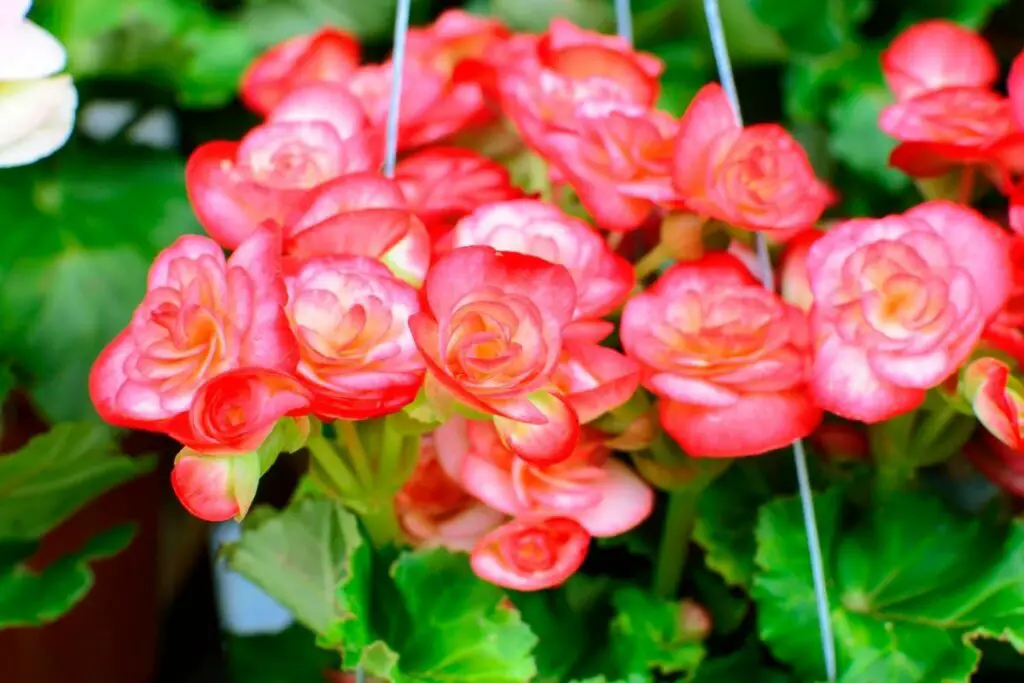
Impatiens are bright, cheerful plants that can light up any space with their beautiful blooms all year round. They look exceptionally well when grown in hanging baskets.
Keeping them up will also help in keeping pest’s fungal infections at bay. You can choose from a variety of flowers they produce, such as pink, red, yellow, purple, white.
Sunlight: Impatiens need a light that is indirect. Partial to full shade is appropriate for them. They do not appreciate full sun but can be acclimated to full sun if the planter wants.
Watering: when growing in hanging pots, impatiens need watering daily, especially when the temperature levels are high. On the ground, they need watering once a week during summer. During cooler months, water is when the soil is dry.
Fertilizing: Fertilize impatiens once a month with a water-soluble fertilizer or a slow-release fertilizer. Fertilize during the spring and summer and avoid fertilizing during the dormant period.
General care: Impatiens are easy to grow plants. With moderate sunlight, you can keep them growing happily. They like well-draining organically rich soil and pots with the proper drainage system. Keep them indoors during frost and away from cold drafts.
Lantana
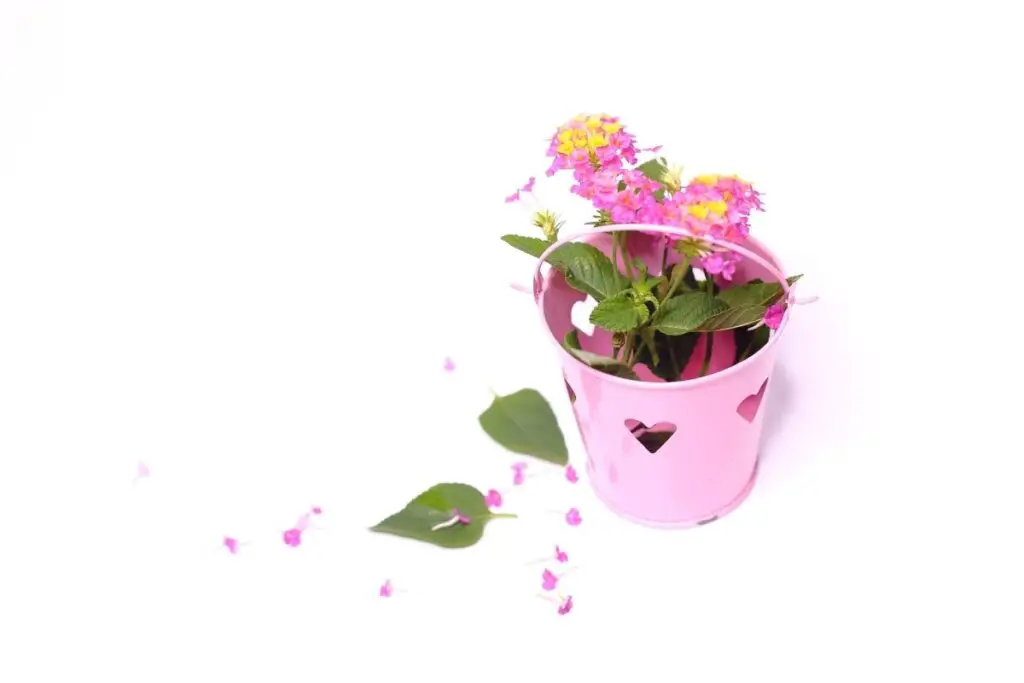
Lantana is a beautiful plant producing aromatic flowers with combinations of colors like red, yellow, pink, white, orange.
They have shrubby branches that spill over when grown in hanging pots baskets.
Sunlight: Lantana likes a lot of light to grow. They thrive in partial to full sun, direct sun for 6-8 hours every day. If you keep them in less light or in the shade, they might not bloom.
Watering: Water your lantana to keep the soil moist. Water them once a week, especially during hot weather. Never let the soil completely dry between watering.
Fertilizer: Lantana is a light feeder; they should be fed only during the growing season. Feed it with diluted fertilizer of 20:20:20 ratio once a month in the growing period.
General care: Lantana is an easy maintenance plant. They will grow temperature levels of 55°F or more and tolerate temperatures as below as 30°F. They are toxic, so keep them in hanging pots.
Looking for gardening supplies? We have tested 100's of products before recommending them to you guys. Check out our best pick below:
| Image | Gardening Supplies | Best Price? |
|---|---|---|
 Top
Top Top
Top | Raised Garden Bed Kit | Check On Amazon |
 | XLUX Soil Moisture Meter, Plant Water Monitor, Soil Hygrometer Sensor for Gardening, Farming, Indoor and Outdoor Plants, No Batteries Required | No Results |
 Top
Top Top
Top | 82 Pcs Garden Tools Set and Extra Succulent Tools Set | Check On Amazon |
 | Joeys Garden Expandable Garden Hose with 8 Function Hose Nozzle, Lightweight Anti-Kink Flexible Garden Hoses, Extra Strength Fabric with Double Latex Core, (50 FT, Black) | No Results |
 Top
Top Top
Top | Dual Chamber Compost Tumbler | Check On Amazon |
 Top
Top Top
Top | Sunnyglade Plant Stakes | Check On Amazon |
 Top
Top Top
Top | Organic Cold Pressed Neem Seed Oil | Check On Amazon |
 Top
Top Top
Top | Mighty Mint Gallon :-Insect and Pest Control Peppermint Oil | Check On Amazon |
 Top
Top Top
Top | Scotts DiseaseEx Lawn Fungicide | Check On Amazon |
 Top
Top Top
Top | Jacks Classic 20-20-20 All Purpose Fertilizer | Check On Amazon |
 Top
Top Top
Top | 30,000 Seeds Pollinator Attracting Wildflower Mixture | Check On Amazon |
 Top
Top Top
Top | Survival Vegetable Seeds Garden Kit-Over 16,000 Seeds | Check On Amazon |
Blue Bacopa
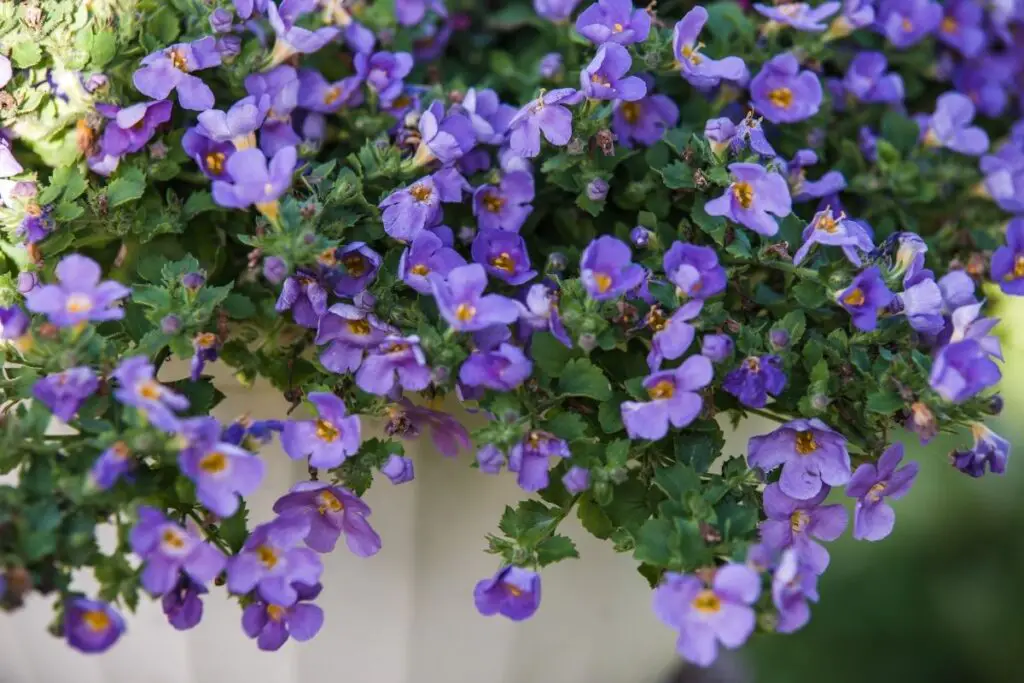
Blue bacopa is a beautiful flowering plant that can be grown in containers hanging baskets. They produce flowers from June through October in different colors like blue, white, pink, lavender, and red.
Sunlight: Blue bacopa like partial to full sun. They need full sun for optimal growth and blooming. Keeping them in the shade will affect their blooming. A spot where it can receive afternoon sun is great.
Watering: Blue bacopa should be kept evenly moist but not soggy. If you keep it under-watered for a long time, its buds drop off as a result of drought stress.
Fertilizer: Blue bacopa should be fertilized once a month only in the growing period. Fertilize with diluted houseplant fertilizer and never over-fertilize. Do not feed the plant in the dormant season.
General care: Blue bacopa likes a well-draining soil mix and proper drainage system, which will allow excess water to drain easily. They are sensitive to cold climates and should be kept away from cold drafts.
Verbena
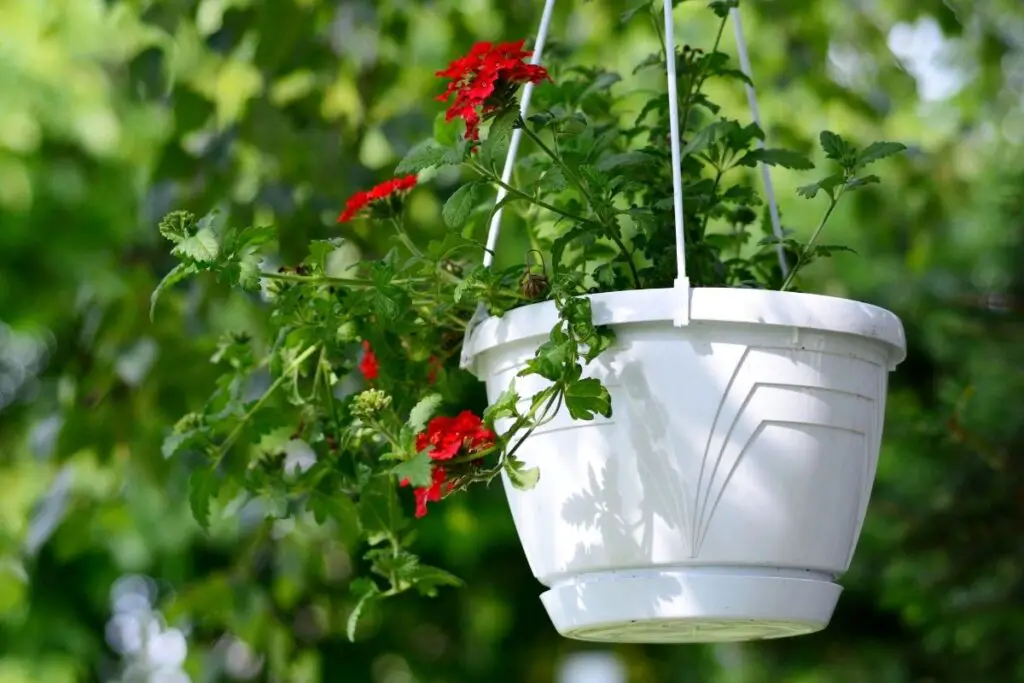
Verbena is an attractive flowering plant that looks even more beautiful in hanging baskets with its branches spilling over.
They produce tiny flowers in a variety of colors like white, red, purple, peach, and pink.
Sunlight: Verbena likes an abundance of light, keeping them in full sun. They need a lot of light for about 8 -10 hours in a day. Low light or shady location will hinder the blooming of verbena.
Watering: Verbena likes to stay moist when young and dry when matured. Keep the soil dry by watering. They can bear short periods of drought. Touch the soil before you decide to water them.
Fertilizer: Verbena is a light feeder but will appreciate feeding during the growing season. Feeding them with a diluted balanced fertilizer once every month will support their growth and blooming.
General care: Grow verbena in well-draining soil with an acidic pH. They can grow in almost all climates but will not be able to tolerate frost. Give them a lot of light and avoid over-watering.
Oxalis Triangularis
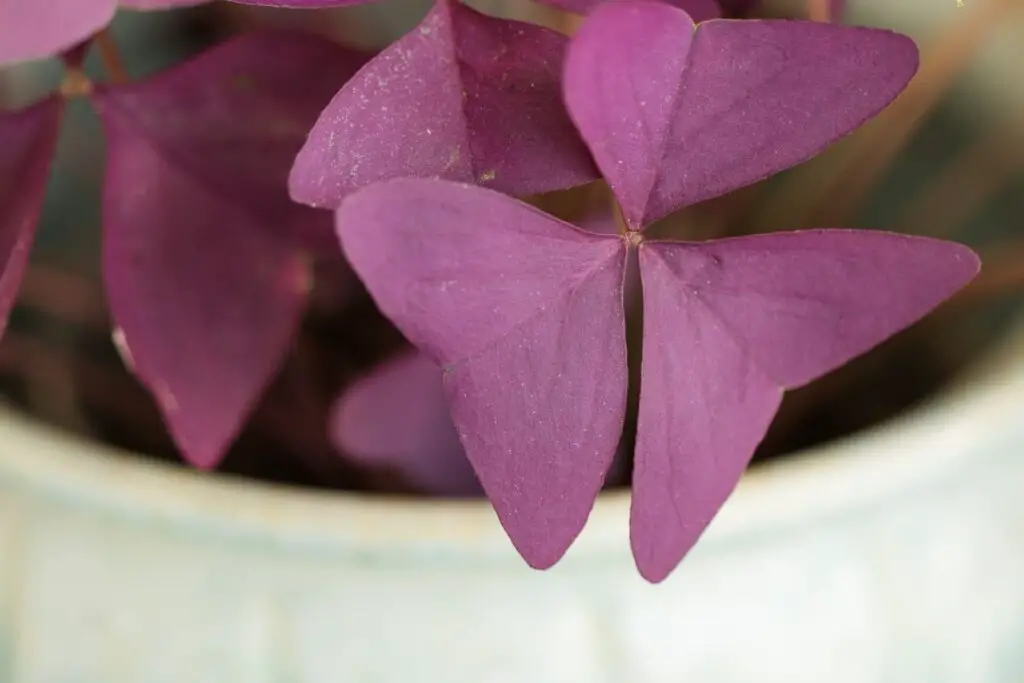
Oxalis Triangularis is famously known for its stunning purple leaves, also known as purple shamrock.
They look amazing when grown in hanging baskets, but you must also know that they are toxic. Along with robust leaves, they produce small flowers in different colors.
Sunlight: Oxalis Triangularis need bright indirect light. Place them in a bright spot or partial sun but not direct light. Low light is also not recommended as it can make the plant weak, affect flowering and make the plant leggy.
Watering: You can water the Oxalis Triangularis when its soil is dry but never over-water it. Overwatering will lead to root rot. Water them when the top few inches are dry, and during the dormant season, water when the soil is fully dry.
Fertilizing: Fertilize Oxalis Triangularis during the growing season, i.e., from spring through summer. Fertilize with a balanced diluted fertilizer once every month in the growing season. Do not fertilize in the dormant period.
General care: Oxalis Triangularis like average to high humidity to grow. They grow best in temperature levels between 60°F to 75°F.
Ivy Geranium
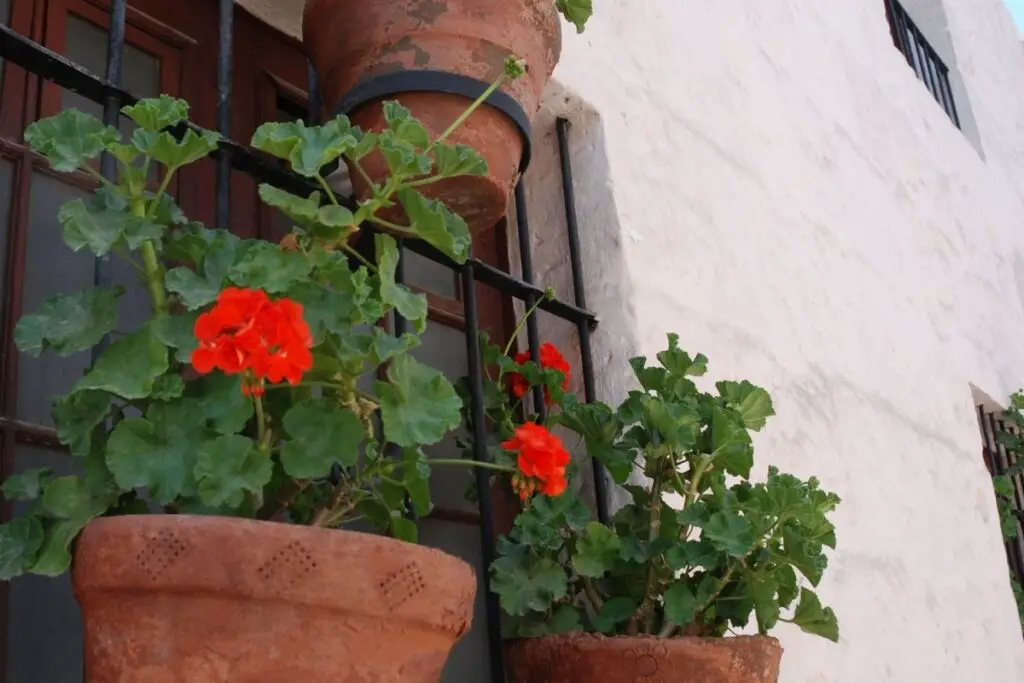
Ivy geranium produces beautiful colors and grows rapidly in growing months.
They are low maintenance and repel flies as a bonus. They look stunning with their branches trailing down from hanging baskets of flowers all over the plant.
Sunlight: If you want your ivy geranium to grow and bloom, then keep them in full sun. If the temperature levels are too high, they keep them in partial sun.
Watering: Water ivy geranium when the soil is dry to touch from the top during summers. During colder months, allow the soil to dry before watering. Never overwater these plants as it can promote root rot conditions.
Fertilizing: Ivy geraniums are light feeders. Feeding them with houseplant fertilizer by diluting it to half the strength or with slow-release fertilizer will be enough. Feed them with fertilizer throughout the growing season and hold them during the dormant season.
General care: Ivy geranium will bloom with little care also. They like moderate temperature and not too high temperature for optimal growth. Keep them in average to low humidity and away from cold and hot drafts.
Lobelia
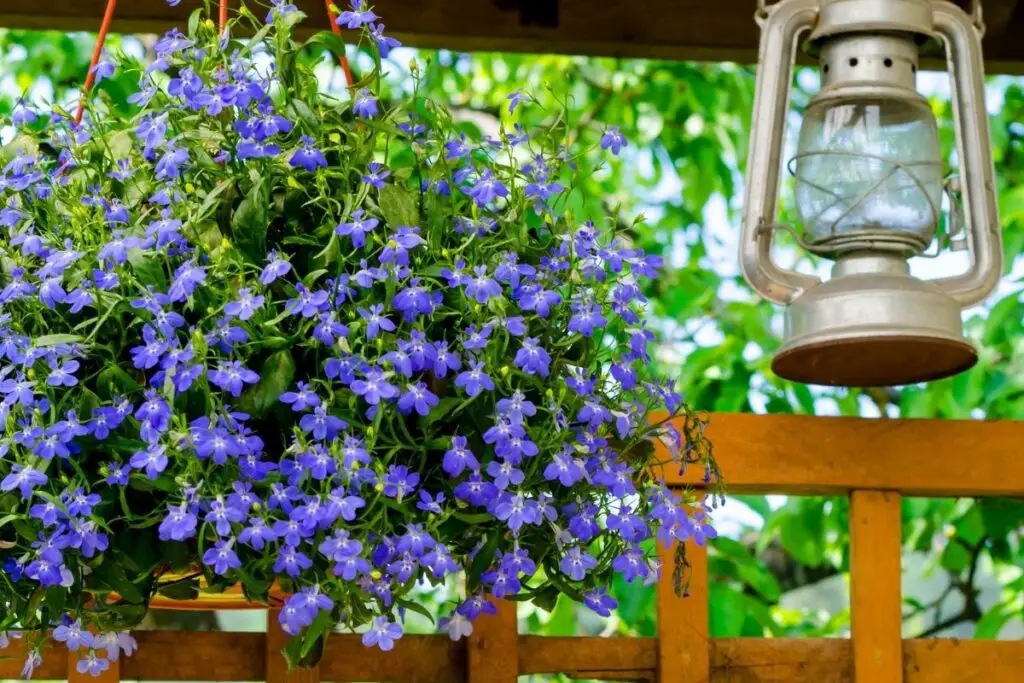
Lobelia is an easy-to-grow blooming plant that comes in many varieties.
Blooms are blue, purple, and white in color, making them perfect for hanging baskets or porch.
Sunlight: Lobelia can grow in partial sun to full sun. If there is low light available, the plant’s growth and flowering will be affected.
Watering: Lobelia likes its soil to stay evenly moist, especially during summer. During cooler months, water it when the soil is dry from within. Check the soil by digging a finger in the soil from the top to check soil moistness.
Fertilizing: Lobelia can be fed with a general-purpose fertilizer. Feed it with fertilizer by diluting it to half the strength. Feed once a month in the growing season and pause in the winter season.
General care: Lobelia likes moderate temperatures and may suffer in high temperatures. To get most of it, keep the soil moist and provide the plant with a lot of light.
Pansy
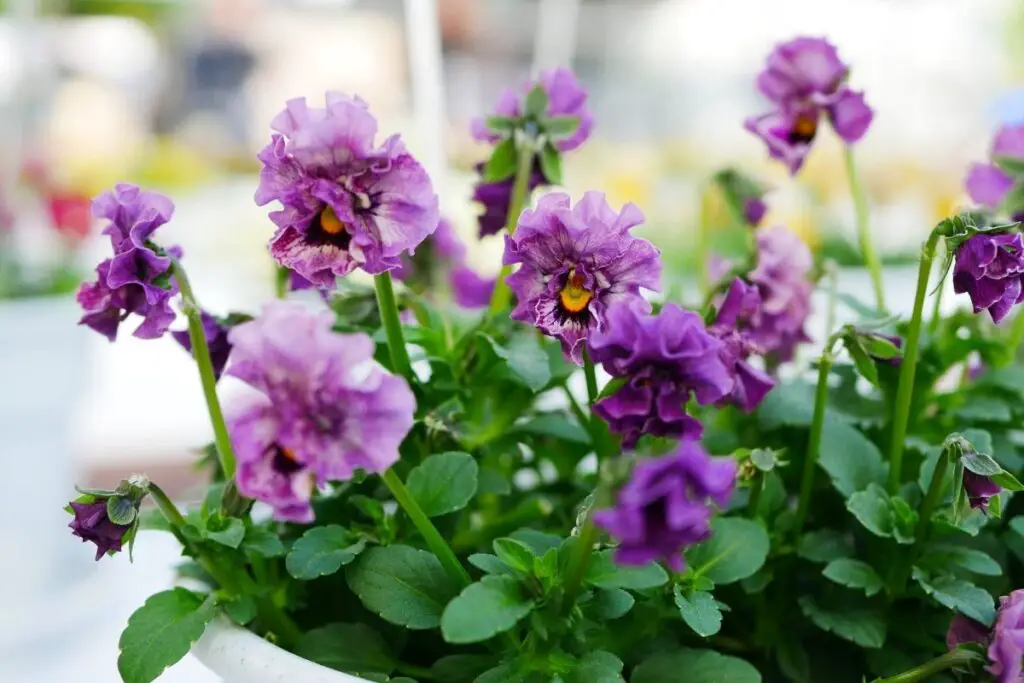
Pansy is an annual plant with heart or round-shaped leaves and velvety blooms in colors like blue, yellow, and white.
They grow well in containers and look beautiful when grown in hanging baskets.
Sunlight: Keep pansy in a spot where there is moderate light available. Don’t expose them to the full sun, so it can inhibit flowering. They like cool weather and will bloom in cooler months.
Watering: Water the plant regularly to keep the soil moist. Do not overwater but keep the soil moist and never let it fully dry.
Fertilizer: Use a general all-purpose fertilizer by diluting it to half the strength. Feed once every month from spring through summer to promote its growth and flowering.
General care: Trim dead flowers to encourage blooming throughout the blooming season. Keep them in moderate temperature levels as they appreciate cooler weather.
Petunia
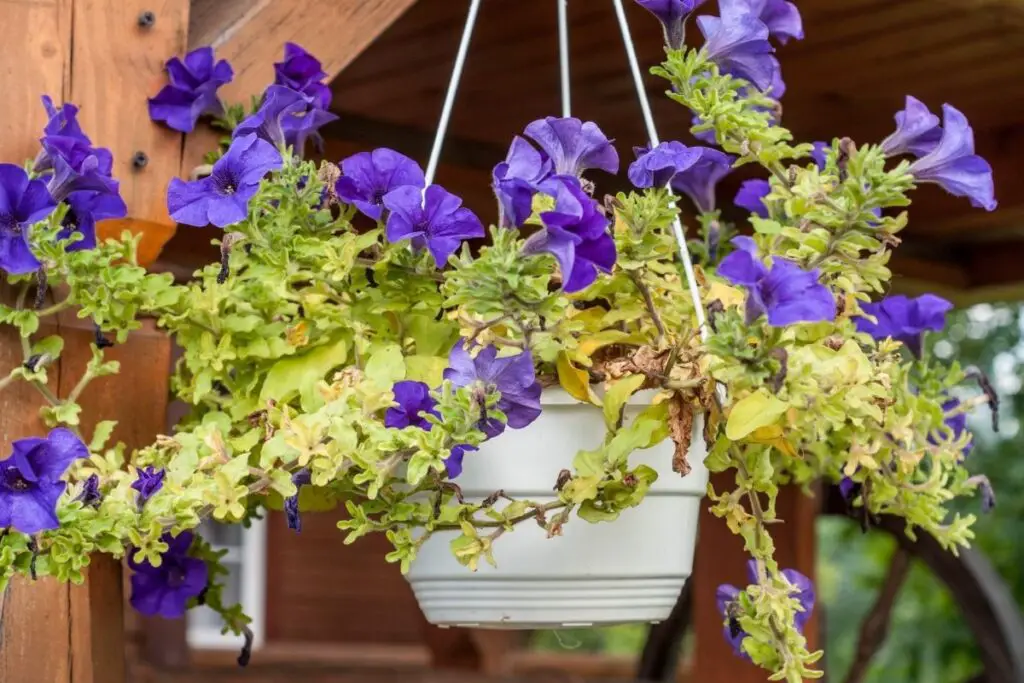
Petunia produces trumpet-shaped blooms that you can find in almost every color.
They look beautiful with their exceptional blooms when grown in hanging baskets. They bloom in the growing period until frost arrives.
Sunlight: Petunia appreciates light and will grow well in partial to full sun. During hot sun, keep them in partial shade as extreme heat can affect blooms.
Watering: Water your petunia when the soil is dried up to 2-3 inches from the top. Do not let the soil dry out completely. Overwatering can also lead to root rot and may even kill the plant.
Fertilizer: Feed from spring through summer with a balanced all-purpose fertilizer. You can also use a compost layer on the top of the soil. Hold on to feeding during the dormant period.
General care: Petunia appreciates temperature levels between 60°F to 75°F. They can tolerate temperature levels as low as 40°F. Plant them in the well-draining soil mix.
Million bells
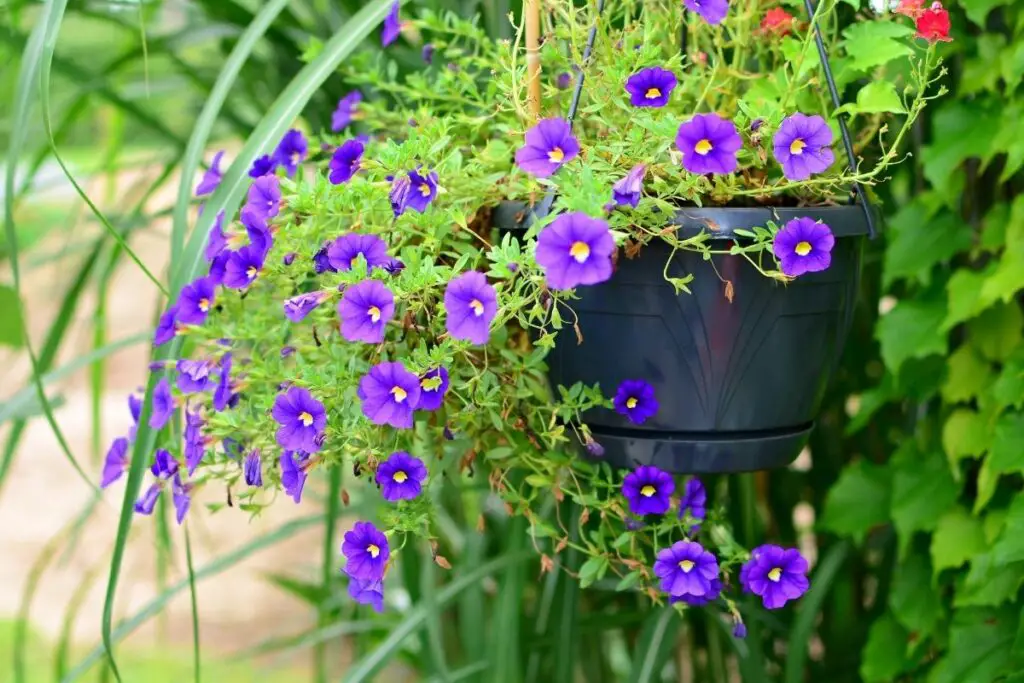
A million bells are known for blooming from spring to frost that spills beautifully over the sides of containers, hanging baskets, etc. the flowers are small oval-shaped and come in a variety of shades of white, purple, pink, red, blue, yellow, bronze, and magenta.
Sunlight: for growing morning bells to their fullest potential, keep them in full sun. You can keep them in dappled sunlight, but it will largely reduce the number of blooms.
Watering: Water the morning bells when the soil is halfway dry. Do not let the plant completely dry out between watering. Test the soil moisture by digging your finger in the soil from the top to check the soil moisture.
Fertilizer: Fertilize morning bells throughout the growing season with diluted liquid fertilizer. It helps in encouraging blooming and staying healthy throughout the year.
General care: Morning bells like warm temperatures but too much heat can harm them. Keep them in high humidity. You can mist around them to increase their humidity.
Sweet alyssum
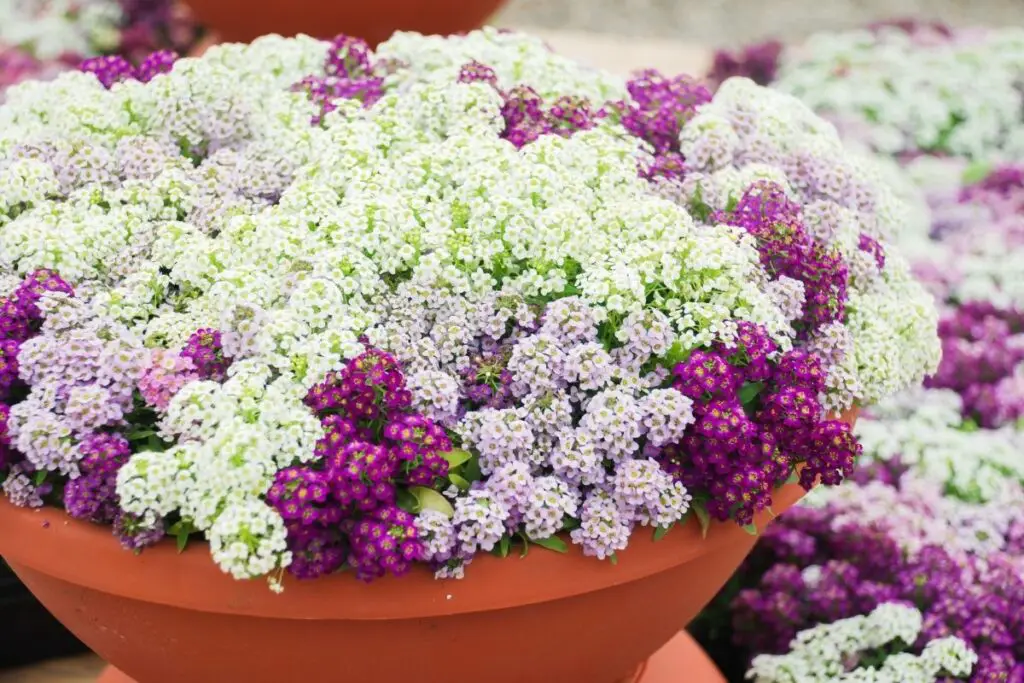
Sweet alyssum has gray-green foliage that is narrow and produces small flowers that cover your garden, landscape, containers. They look amazing when grown in hanging baskets.
Sunlight: Sweet alyssum likes a lot of light to grow vigorously and bloom too. Keep them in full sun as much as possible. If the air is dry, then you can keep them in partial shade as they do not appreciate dry periods.
Watering: Sweet alyssum should be watered once a week and allow excess water to drain out. Keep the soil evenly moist between watering.
Fertilizer: Feed them with balanced houseplant food once every month. Feed only in the growing season as it will help the plant to grow and bloom easily.
General care: Sweet alyssum-like warm temperatures and average to high humidity. When the humidity is high for long periods, reduce watering to maintain ideal humidity. They like well-draining soil mix and will suffer if the soil is heavy.
Portulaca
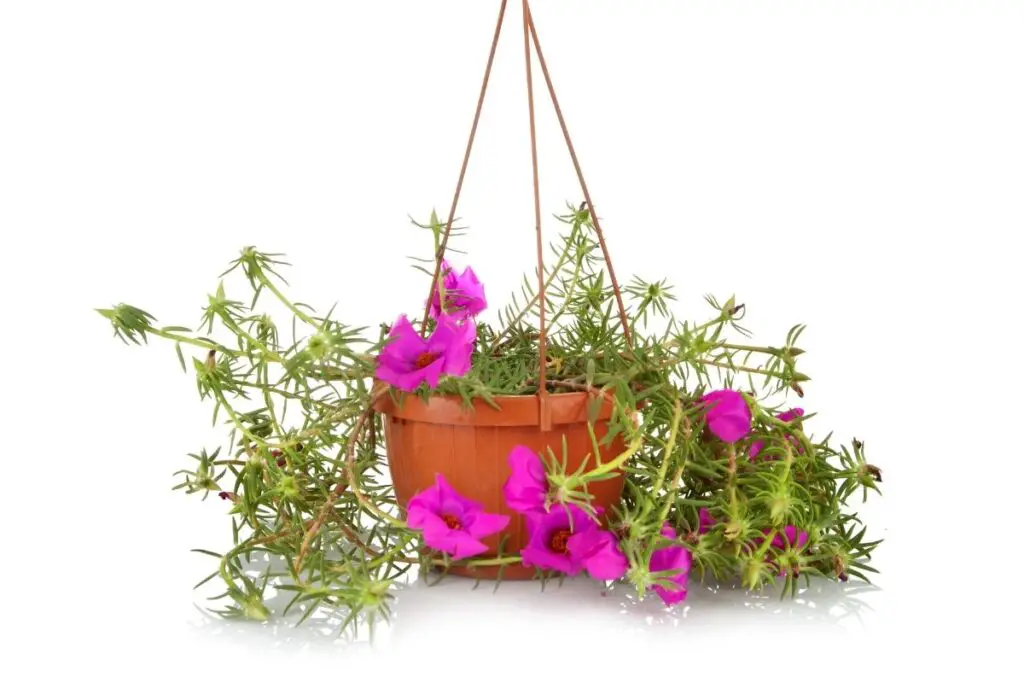
Portulaca is succulent and grows rapidly, and helps you cover the bare spaces easily.
They produce cheerful small blooms in a variety of colors. They look and grow easily and look stunning in hanging baskets too.
Sunlight: Portulaca needs a lot of light to grow rapidly. Keep them in 6-8 hours of direct light and may not bloom in low light conditions. They are highly tolerant of heat.
Watering: Portulaca should not be watered regularly as their root system is very shallow. Just light watering when the soil looks dry is good enough. Their leaves retain moisture, due to which the plant doesn’t need too much watering.
Fertilizer: Portulaca needs very little feeding and will survive even without feeding. Fertilize when planting it with a balanced diluted fertilizer to encourage growth and blooming. Never over-fertilize as it can hinder blooming.
General care: Portulaca can thrive in dry conditions. Trim them during summer only when they become lanky. Remove spent flowers to avoid reseeding.
Lotus vine
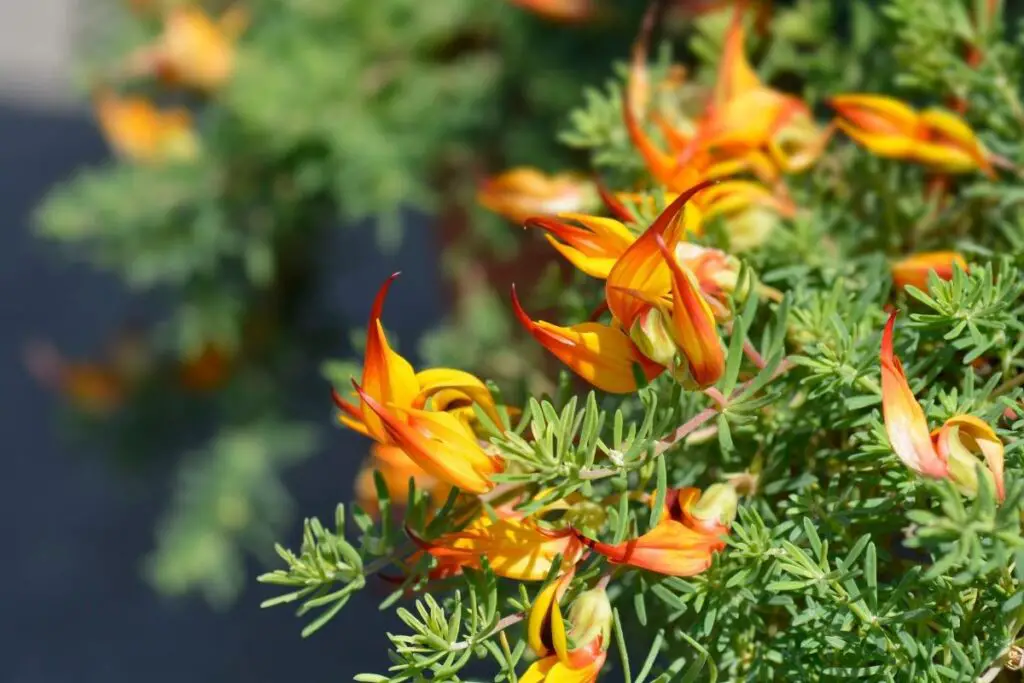
Lotus vine is a perennial plant that is great for growing in hanging baskets.
They produce golden flowers with red or orange tips throughout the growing season and may bloom even in early fall in favorable conditions.
Sunlight: Lotus vine likes full sun and during the intense sun, keep them in partial shade during the afternoon. Low light may hinder their growth speed and flowering.
Watering: Lotus vine should be watered in regular intervals, especially until they are matured. They are drought tolerant but stay healthier when kept moist. They like moist soil but are not soggy, leading to root rot.
Fertilizer: Feed lotus vine in the early spring to promote new growth with a balanced, liquid fertilizer. Never feed during the dormant period.
General care: You can trim the lotus vine to induce branching and avoid leggy growth. Also, it keeps them in good shape. Use well-draining slightly acidic soil mix for them. During winters, they can tolerate temperature levels up to 50°F.
Reference: Louisiana State University Agricultural Center, University of Kentucky, MSU, University of New Hampshire Cooperative Extension.
